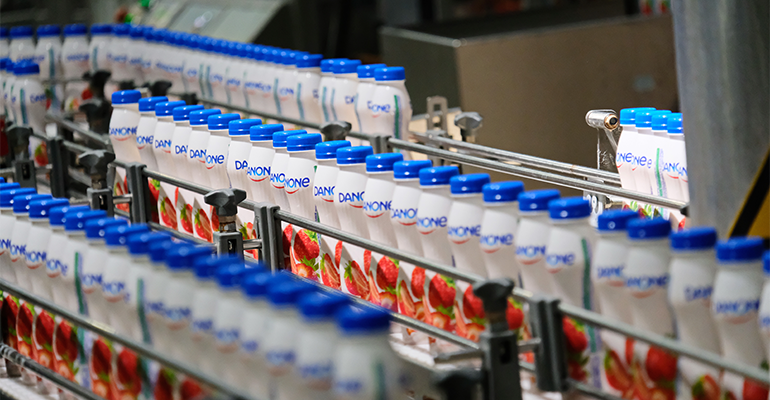News
FAO: commodity prices dipped in October
7 Nov 2018International food commodity prices dipped in October, as falling dairy, meat and vegetable oils prices more than offset a surge in sugar prices, the United Nations said.

International food commodity prices dipped in October, as falling dairy, meat and vegetable oils prices more than offset a surge in sugar prices, the United Nations said.
The FAO Food Price Index, a measure of the monthly change in international prices of a basket of food commodities, averaged 163.5 points in October, down 0.9% from September and 7.4% below its level a year earlier.The FAO Dairy Price Index led the overall decline, slipping 4.8% from the previous month and 34% below the peak reached in February 2014. The weaker prices reflect increased export supplies across all major dairy products, especially from New Zealand.The FAO Meat Price Index declined 2.0% from September, with ovine, pig, bovine and poultry meat all posting drops due mostly to abundant export supplies.The FAO Vegetable Oil Price Index fell by 1.5%, its ninth consecutive monthly drop, to reach its lowest level since April 2009. The latest slide was mostly driven by sluggish global import demand for palm oil and large inventories held by the commodity's major exporting countries. International soy oil prices increased slightly.The FAO Cereal Price Index rebounded, rising 1.3% from September, mostly due to firmer maize quotations from the United States of America. Rice prices, by contrast, fell, partly influenced by currency movements weighing on Japonica and fragrant varieties.The FAO Sugar Price Index surged 8.7%, mostly as a result of negative climate-related production prospects in India and Indonesia as well as indications of an increasing share of Brazil's sugarcane output being used to produce ethanol. FAO has also raised its forecast for global cereal production in 2018 to 2 601 million tonnes, primarily due to higher estimates for wheat production in Canada and China. Nonetheless, the new forecast remains 2.1% below the record level achieved in 2017.Global rice output this year is expected to surpass last year's all-time high by 1.3%, reaching 513 million tonnes, according to FAO's latest Cereal Supply and Demand Brief.World wheat production in 2018 is now forecast at around 728 million tonnes, marking a 4.3% decline from the previous year. Winter wheat crops, to be harvested in 2019, are currently being sown in the Northern Hemisphere, while in the European Union, the United States and India generally remunerative prices are expected to stimulate an increase in plantings.Worldwide output of coarse grains is forecast at 1 360 million tonnes, a 2.2% drop from 2017. Coarse grain crops are currently being planted in the Southern Hemisphere countries, and early prospects indicate an expansion in maize plantings in South America.FAO expects world cereal utilization to rise by 0.2% to a record 2 653 million tonnes, spurred by higher feed and industrial uses of maize, especially in China and the United States. The use of wheat for food consumption is anticipated to rise by 1.0%, while that for rice to increase by 1.1%.Worldwide cereal stocks at the close of seasons in 2019 are now forecast to reach almost 762 million tonnes, some 6.5% below their record-high opening level.Total inventories of coarse grains are expected to fall for the first time in six years, while those of wheat are set to decrease by 4.5%, with drawdowns to be led by major exporters. World rice stocks, by contrast, are expected to rise by 2.6% to 176.6 million tonnes.International trade in cereals is now forecast to decline 1.1% from the 2017/18 record level, with trade in both wheat and rice contracting. World trade in coarse grains is still forecast to remain close to the previous year's record level, at around 195 million tonnes, with maize volumes increasing while those of sorghum declining.Related news

Oat Barista: Innovation for game-changing beverages
20 Nov 2025
Oat Barista is a clean label, sustainable, and innovative drink base specifically designed to create the perfect foam in one single ingredient.
Read more
How younger consumers are redefining ingredient choices and rejecting brand loyalty
18 Nov 2025
Gen Z and millennial consumers’ preferences for transparency, functionality, and purpose are “redefining the very nature of consumption itself”, says SPINS.
Read more
Hybrid formats and flexible positioning to disrupt category norms in 2026
17 Nov 2025
Trend forecasters expect food and drink to move more fluidly across occasions, functions, and formats as consumers seek versatility, novelty, and convenience.
Read more
Danone highlights digestive health as potential ‘tipping point’ for food industry
13 Nov 2025
Danone is betting on a food industry “tipping point” that will bloat the market for healthy products, particularly those related to gut health.
Read more
New UPF standard hoped to offer consumers ‘coherence and clarity’
10 Nov 2025
Ingredients companies are being urged to enter “a new era of partnership and innovation” following the launch of the industry’s first non-UPF verification scheme.
Read more
Faravelli at Fi Europe: Showcasing FARA® functional solutions for food and nutra
28 Oct 2025
At Fi Europe 2025 in Paris (stand 72M39), Faravelli showcases FARA® Customized Functional Solutions and a wide ingredient portfolio for food and nutra – delivering quality, innovation, and expertise.
Read more
Agrigum Redefined FIBER
27 Oct 2025
Agrigum has transformed gum acacia into a natural, science-backed fibre that supports gut health, sustainability, and innovation across global food and nutrition applications.
Read more
Expanding boundaries in food & beverage innovation
23 Oct 2025
IMCD and FrieslandCampina Professional expand partnership to deliver Kievit® across EMEA, enabling brands to enhance quality and accelerate time-to-market for tomorrow’s food & beverage creations.
Read more
Amazon Grocery launch aims to balance quality with affordability
22 Oct 2025
Global e-commerce giant Amazon has introduced a new private-label food brand, combining existing Amazon Fresh and Happy Belly products with new everyday items.
Read more
Powerade enters hydration space with launch of Power Water
21 Oct 2025
Coca-Cola’s Powerade brand has launched a zero-sugar, electrolyte-enhanced functional water, marking the brand's entry into the hydration space.
Read more